Interview by Michael McCarthy
New England artist QUIBX explores the complicated realities of existence through bold, mixed media work that’s dark, layered, and instantly recognizable. He often begins by sketching with pencil and ink — a nod to his comic book roots — before scanning and coloring digitally. The results are striking: pieces that feel influenced by skateboard graphics, album covers, and cult films, but aren’t quite any of those.
Skeletons are a recurring motif, but rather than to shock, they’re used to reflect on life itself — emotional states, personal trials, fleeting moments. QUIBX’s work is emotionally rich, often unsettling, and undeniably original. His style keeps evolving as he experiments with new tools and channels fresh influences.
I’ve followed his work for years and watched that evolution up close. While I’m not an art critic — and covering visual artists is new ground for Love is Pop — there’s always been something about QUIBX’s art that makes it unmistakable. It’s visceral. It stays with you. It has that je ne sais quoi that all legendary and truly unique artists have.
His work appears regularly at local festivals and events, including Pancakes & Booze and the Mosaic Art Collective, and now you’ll also find it through SeflMade, his new studio formed in partnership with Salty Jewelry for Assholes.
I’m honored to present this interview and a selection of his art. If you like what you see, visit his official site QUIBX.art and Sefl Made to check out what he’s creating next.
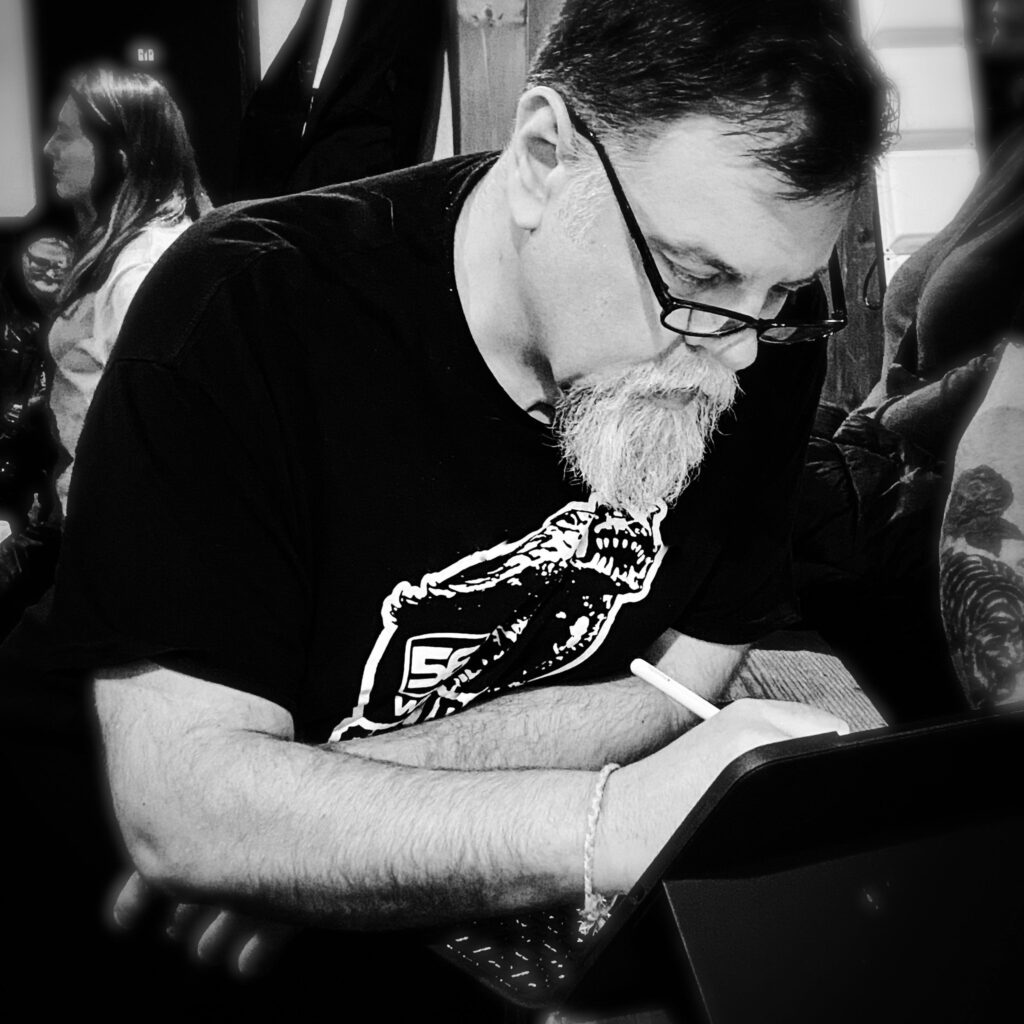
MM: Well, first of all, you are doing a new collaboration.
QUIBX: Yes.
MM: A studio, I believe. What can you tell us about all of that?
QUIBX: So, the idea, the studio is called Sefl Made, not Self Made, Sefl Made. And it’s called that because my partner has knuckle tattoos, and she’s dyslexic, and her tattoo artist is dyslexic, and she had gone to get a tattoo that said Self Made, and the guy spelled it wrong. And they got it done and then they realized after the fact that it was spelled wrong. And she just thought that was like “the most me thing” that she could have done, and so she left it alone, didn’t fix it.

MM: Nice. I love that.
QUIBX: That was years before we had met. Then when we met and we started working together, we decided to start doing shows together, and it was weird to book a show under one name or the other name, because we’d get there, and they were expecting, you know, jewelry, and then it’s art, or vice versa. So we realized we needed like an umbrella thing to put both of our creative things under when we do shows together, and that just struck me as a really interesting story and a unique kind of brand. That sort of summed up kind of like what we were about, and so we decided to use that as our brand for when we do shows together. We still keep our own unique artistic identities, but for the purposes of doing shows and just building a brand that has worked out great.
MM: What about making collaborative artwork? Like, you draw something, like how with comics someone does pencils and someone does ink. Different people work on the same piece together. Will there be any type of collaborating like that?
QUIBX: We’ve started to. Our styles are a bit different, but we have complementary skill sets. So, for example, one of the things that she is working on is these ideas of twisted tarot cards. And we wanted the tarot cards have all these things like the hanged man, and so she’s taking some kind of pop-cultury things and integrating them. One of them was a Godzilla one for the tower, and the card says “Fuck this tower”. And so she drew Godzilla, but she wasn’t getting the geometry of the tower right so, I went in and did the tower. It’s her idea, her design. But I went in, did the tower, cleaned up the line work, brought it into the computer, made it print ready, that kind of thing.
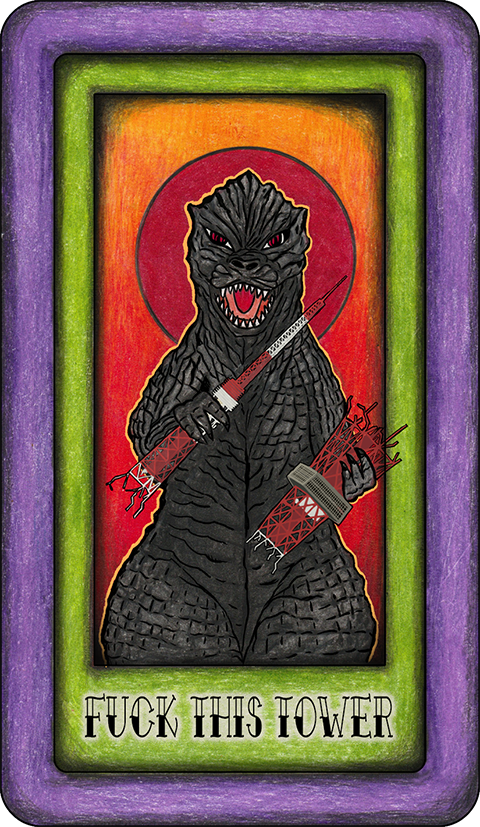
MM: That’s great.
QUIBX: So that was like the first collaboration we did. And then she had some paintings that she was thinking of doing, and I had pulled out of storage a binder of old artwork that I had done in high school, that it was all photocopies. I was trying to put an old book or catalog together, and I have all the originals still, so these are all just old photocopies. And I was like, I don’t know, you want these? She’s like, yeah. So, she took them and cut them up and started using them in collages on paintings that she’s working on. So, in a weird way, it’s like a hybrid version of our art that’s using some of my art and some of her art.
MM: Very clever. Reminds me of how I make decoupage collages with stuff I cut out of magazines.
QUIBX: And now our collaborations are more like learning a new skill together. The last couple months we started learning linocut printing. So, getting these rubber pads or tiles where we can carve out a negative and then print and make one-of-a-kind things. And we kind of learn those together and we will put them all in a box together, but it’s her pieces and my pieces, and they all are the same kind of thing. We have a few projects that we’re thinking of doing that are going to be collaborative, too. So, yeah, we’ve been doing it. It’s really interesting.
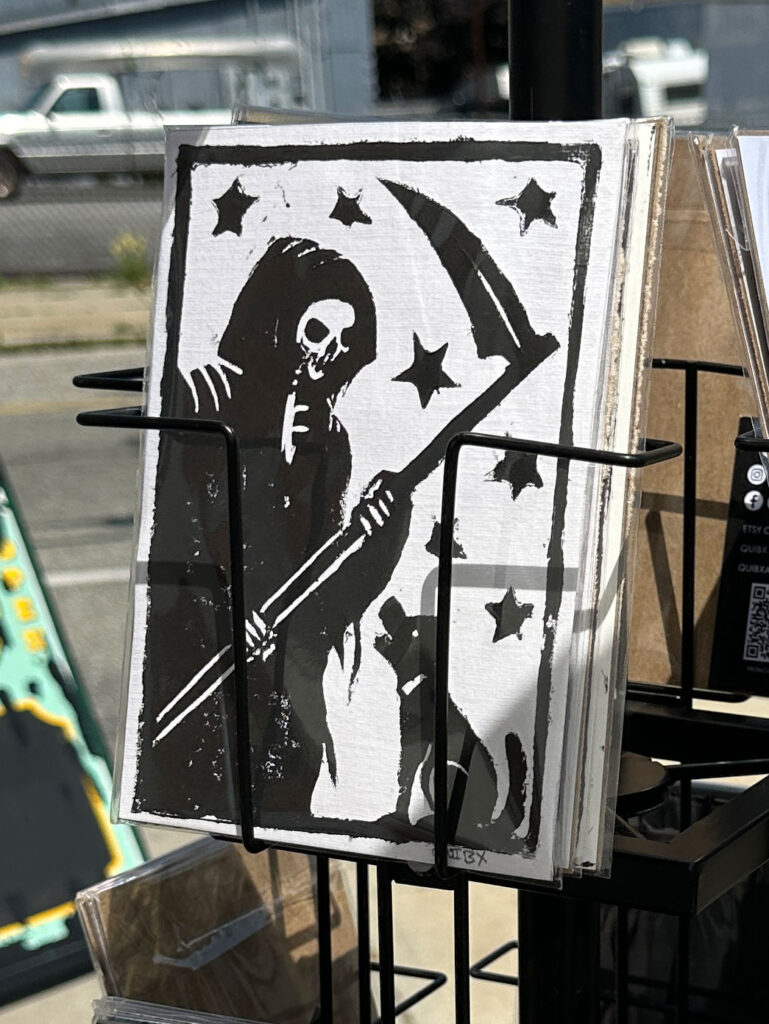
MM: That’s something new for you, right?
QUIBX: I’ve never had a creative partner in that capacity. You know, usually it’s, you’re doing your thing and I’m doing my thing, and I can offer advice or something, but to have actual pieces that are, like, a true collaboration is pretty cool.
MM: You go by Quibx, which I am pronouncing like Quib-X. Am I saying it right?
QUIBX: Yeah, yeah. When people come up to the booth or whatever and they ask how to say it, I tell people it’s like saying Québec, like the city of Québec. You know, it’s got the same tone, but it’s obviously not an intuitive thing to say. You know, some people say it like “Quibics”, some people say “how do you pronounce that?” And I don’t mind if people say it wrong?
MM: What’s the origin of that?
QUIBX: I developed that because it was my handle online for years, and when I started selling, I realized that I have a professional job, and I wanted to keep my art life sort of separate from my professional life, so why not just keep using that moniker as a brand? And a lot of the artists that I admire use sort of pseudonyms and pen names, Pushead, Banksy, etc. And I thought, well, it’s not without precedent, and what was the word Banksy before it was anything? It almost sounds like gibberish, right? So it’s one of these things where some of these words seem weird until you just use them in normal culture, and then they’re fine, and that’s kind of what I’m going for.
MM: But Quib was a word you made up years ago, right?
QUIBX: Its origins go back to the 90s, and I used to work at a newspaper overnight, and a friend of mine would work there as well, and we worked on these heavy machineries that were very loud, so we couldn’t really talk. So we would pass notes. I’d be on one machine, he’d be on another machine, and we’d write silly, stupid things or whatever, like jokes. And as a joke, I think I wrote back a math equation that was just ridiculous, would never be solvable, and he wrote back, and the answer was quib, just a made-up word. And so that became my first internet handle, and I used that for a bit on AOL. But when I went to register the domain, it was taken, oddly. So I just added an X to the end of it. I just sort of migrated to that, and that’s what it’s been all that time.
MM: Nice. Now, I seem to remember that you went to college for art.
QUIBX: Sort of. I went to community college, not an art college, but I took largely art programs. At the time, it was called graphic design, which is sort of a dated term now, but this is the early 90s, right? So it’s the college I could afford. I wanted to go to the Savannah College of Art and Design or Rhode Island School of Design, but we couldn’t afford it. So community college was the answer, and it was great. I learned so much. The school I went to definitely punched above its weight in terms of the caliber of education it gave you, especially in art, you know? So I did get art training, but it wasn’t an art school, so to speak. I also had to take Western Civ and math stuff. It was not just art all the time, you know? But there were a lot of cool creative opportunities there.
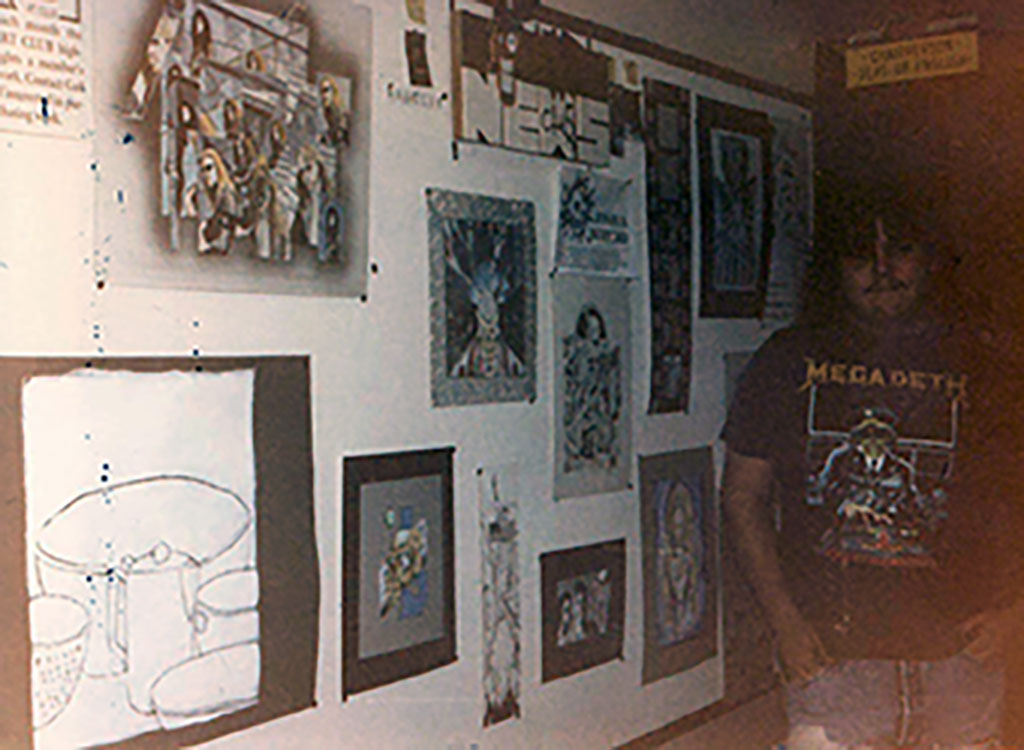
MM: Definitely sounds like it was a good experience for you.
QUIBX: I did some co-ops. I did a summer co-op at a screen printing place, and I learned a lot about that stuff. I painted some murals around the campus. I was in the art club. There was a lot of opportunities there. It was pretty cool.
MM: You’ve also worked for quite some time making signs and stuff.
QUIBX: Yeah.
MM: Did that come in to help your art in some way?
QUIBX: Yes, because working in that industry showed me the practical tools to do stuff. Like, you can have a lot of great ideas, but learning how to shoot film and cut vinyl and work with different materials was important. I started out in the screen printing shop just doing grunt work, like blowing out screens. When you do screen printing, there’s a screen that you push ink through that at the end of the job that you reclaim, so you use a chemical that erases the old design so you can reuse the screen again. My first job was cleaning those screens with hazardous chemicals, but I began to understand the process of how art became a product. The people there, to my luck, were very supportive. Like, why don’t you, one day a week, go upstairs and learn the design program on the computer for making signs? Then I transitioned up there to do making vinyl signs, truck lettering, and that kind of thing, to designing signs myself. I had cool opportunities.
MM: Do you remember any of the signs you made?
QUIBX: We painted a banner for the Clinton-Gore campaign in 1996 that was on CNN. We did it in 24 hours, and it was my painting. So I took those skills that I was learning in college and took it into a practical application. I learned how to scale up my design. I learned what materials to use that were going to be durable, all of these things that merged those worlds together. And I still use a lot of those skills today when I’m doing art. I plan it almost like it’s a sign job in a way. I think about the end product at the beginning and how I’m going to execute this design when I’m starting it so I don’t design myself into a corner, in a way.
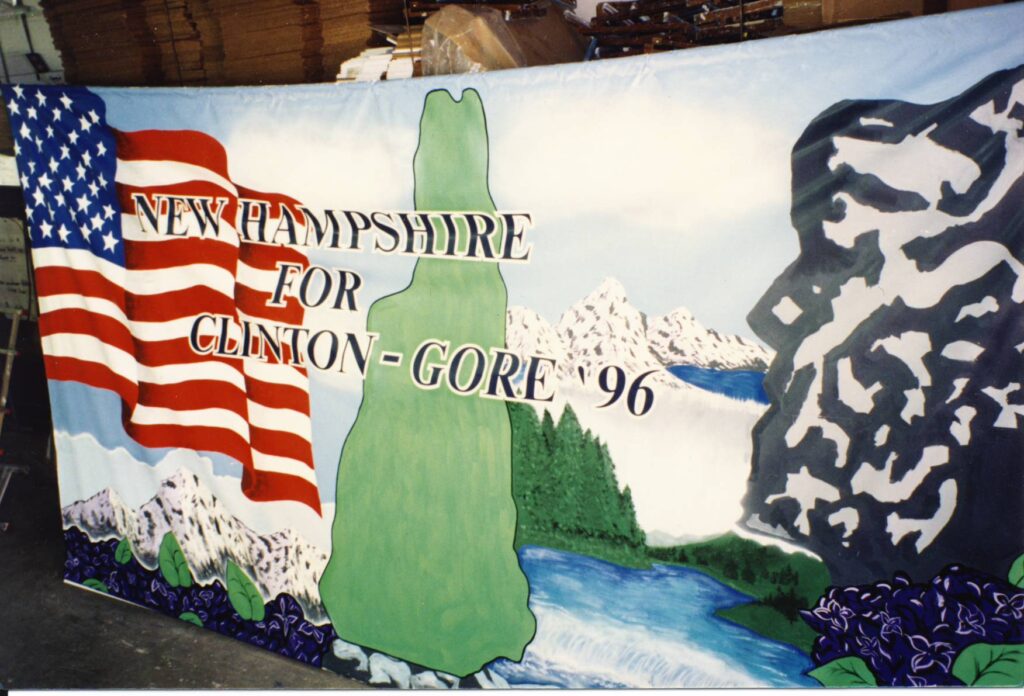
MM: This is interesting because I was going to ask you if you feel like you do your best work when you plan what you’re going to create beforehand or when you just sit down and kind of wing it?
QUIBX: It’s interesting because I think there’s different parts of the creative process that work differently. The ideas come without thinking of the end result. You know, like, “Oh, this would be cool if I did this, right?” But when I sit down to go, “okay, I’m going to make this”, I sit down with the plan, right? So the idea comes spontaneously, but the execution is methodical. And I think because of that, it takes me longer. When I was young, I would do a drawing a day. I’d just put pen on paper and then draw it. But now I realize that if I’m going to make products, you’ve got to create art in such a way that can be used in different scales, different sizes and mediums.
MM: Makes sense.
QUIBX: You’ve got to think about how your colors are going to be printed and work, what kind of substrate they’re going to be on. So now I have that cool idea, but there’s more thought into how it’s going to be executed. And so it could take me a month or two months to get a piece done. So I may not be as prolific as some others but I think that’s just part of my process.
MM: You have to do what works for you.
QUIBX: It’s just the way it works. And because I have a day job, I have the fortune and the ability to take my time because it’s not like if I don’t do this art, I don’t live, you know?
MM: Sure. So, in addition to your entirely original art, you’ve drawn a lot of famous characters, like the clown from It and Krampus and the Creature from the Black Lagoon. When you draw other people’s characters, though, you always seem to put your own unique twist on them. How important is that to you?
QUIBX: Oh, I mean, it’s important. Ultimately, the art that I always loved is the type that you look at it and go, that’s that guy’s piece, right? So I want to have a feel that you look at the pieces and go, that’s Quibx’s, right? And I’m getting that now, at least locally. I go to shows and people go, oh, I recognize this work, which is great. The character stuff, I don’t really do anymore.
MM: Makes sense that you’d want to focus on completely original art now that you have enough character stuff to draw people in.
QUIBX: Everybody goes on a journey when they’re finding what works and what doesn’t work for them. The first thing I started doing was at Comic-Cons. And horror conventions. And they’re very character-focused. People aren’t so interested in your original designs, but they’ll buy Jason or Freddy or Boba Fett or whatever. So if you go to any artist alley in Comic-Cons, 98% of the work is somebody else’s characters and this artist’s take on them. But what I was learning as I went through my journey is that the characters brought the people into my booth, but more often than not they leave with my original work.
MM: Which is the ideal situation.
QUIBX: And now I’d say my original work outsells my character work by four to one. But it still serves a purpose to people who see it across the room and go, oh, I’m going to go over and look at this. It’s a Stormtrooper head or whatever. But then they leave with original designs. So I haven’t done a character in four or five years because I’m having such success with my original work.
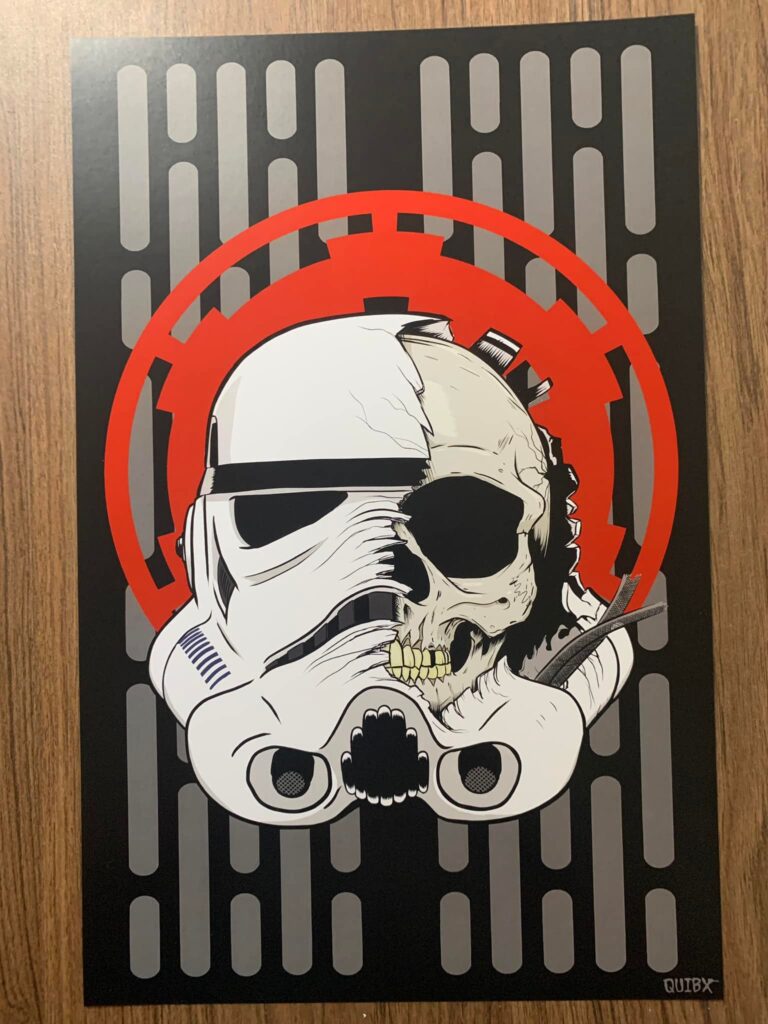
MM: Do you get burnt out on that at all?
QUIBX: Well, it’s not burnt out, but popular culture is fickle. You do an anime piece and if the anime is hot, you sell a lot of them. But if you take too long and the anime is over and they move to something else, you’re stuck with a bunch of prints you can’t sell.
MM: Ah, I can see how that would be frustrating.
QUIBX: There are some things that are evergreen like Frankenstein. Frankenstein is never going to go out of style. But if you go for whatever the hot anime is now, you might sell a shit ton of them at one convention, but six months later you’re stuck with them and nobody wants them. So rather than play that game, I just keep ones like my Universal Monsters that are always popular.
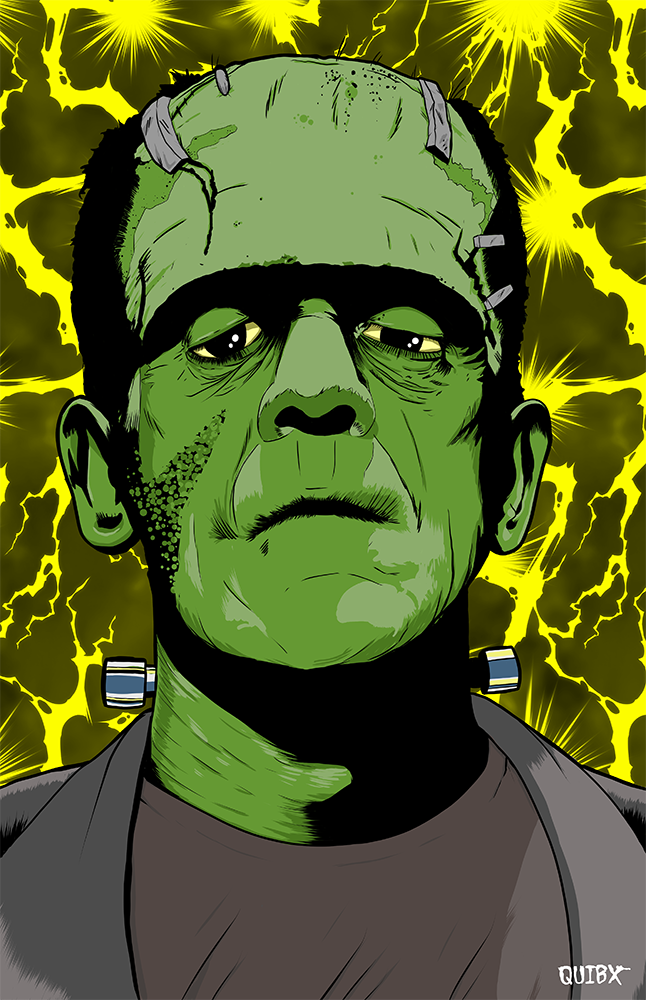
MM: What are some things that are always popular?
QUIBX: Godzilla is always popular. Star Wars is always popular. But doing things like Marvel or anime or whatever, it’s just so fickle and unreliable. And there’s also this economy of space when you’re traveling and doing shows that you can’t stock a hundred prints. You’ve got to pick what are your good sellers.
MM: I imagine it must take time to figure out what sells and what doesn’t.
QUIBX: Yeah, just weeding that kind of stuff out over time so it’s just more efficient. And it lets me focus on things that I want to draw rather than appeasing the masses. Because there are a lot of working convention artists where that’s what they do. That’s their job. And if they want to continue to survive and make money, they have to stay relevant. And that means having current and topical characters that people want to buy. It’s like your local comic store that all of a sudden is selling Pokemon cards and then Pop! figures and then Magic the Gathering. They’re just trying to stay in business because that’s what the people want. And that’s the kind of business that artist alleys typically are. I’ve started to shift more to art as opposed to fandom. And so I’m doing more shows that are displaying art. And that’s become my niche, I think.
MM: Nice. And I think was your goal when you started in the beginning anyway, right?
QUIBX: Yeah, absolutely. There’s always been a lot of original stuff that I’ve done. And it’s cool to do some [fan] stuff every once in a while just because I really like a property or whatever. But it’s not what my brand is now.
MM: I imagine it’s similar to if you’re in a band and you’d rather do your original music than covers.
QUIBX: Right. Imagine a band that just does covers. They’re only going to get so big. They may be like the biggest cover band in the Northeast, but they’re just going to play the lounge at your local Chinese joint or maybe a small theater. But you do original stuff that resonates with people and you’re now open to bigger things.
MM: Right.
QUIBX: Nobody’s hanging paintings of Boba Fett in the MoMA.
MM: When you meet people at fairs and festivals and stuff, do you ever get people that are always like, come on, tell me your legal name or anything like that?
QUIBX: It’s interesting. People are strange and they’re always fascinating to me. And I feel like I’m an alien talking to people sometimes. Doing shows has definitely made me come out of my comfort zone and be able to talk to people. But some people come up to me like, oh yeah, what’s your name? And they’ll put their hand out. And I feel weird saying, Quibx. So I’ll say my name. It’s not a big secret, but I don’t advertise it. So I don’t mind introducing myself with my name in person, but just as a rule online it’s Quibx. If you were to look at a lot of people who use pseudonyms, their names are out there. Like Alice Cooper’s name is Vincent Furnier. There’s all these famous people that have actor names and then their real names are out there, but you just go, oh, it’s Elton John. And that’s the way I’m kind of looking at it. I’ll introduce myself in person that way unless it becomes more of a thing. But I feel weird if people are going to be like, hey, Quibx. It just doesn’t feel normal in a way. It’s more like a brand than me, I guess. I don’t know if that makes any sense.
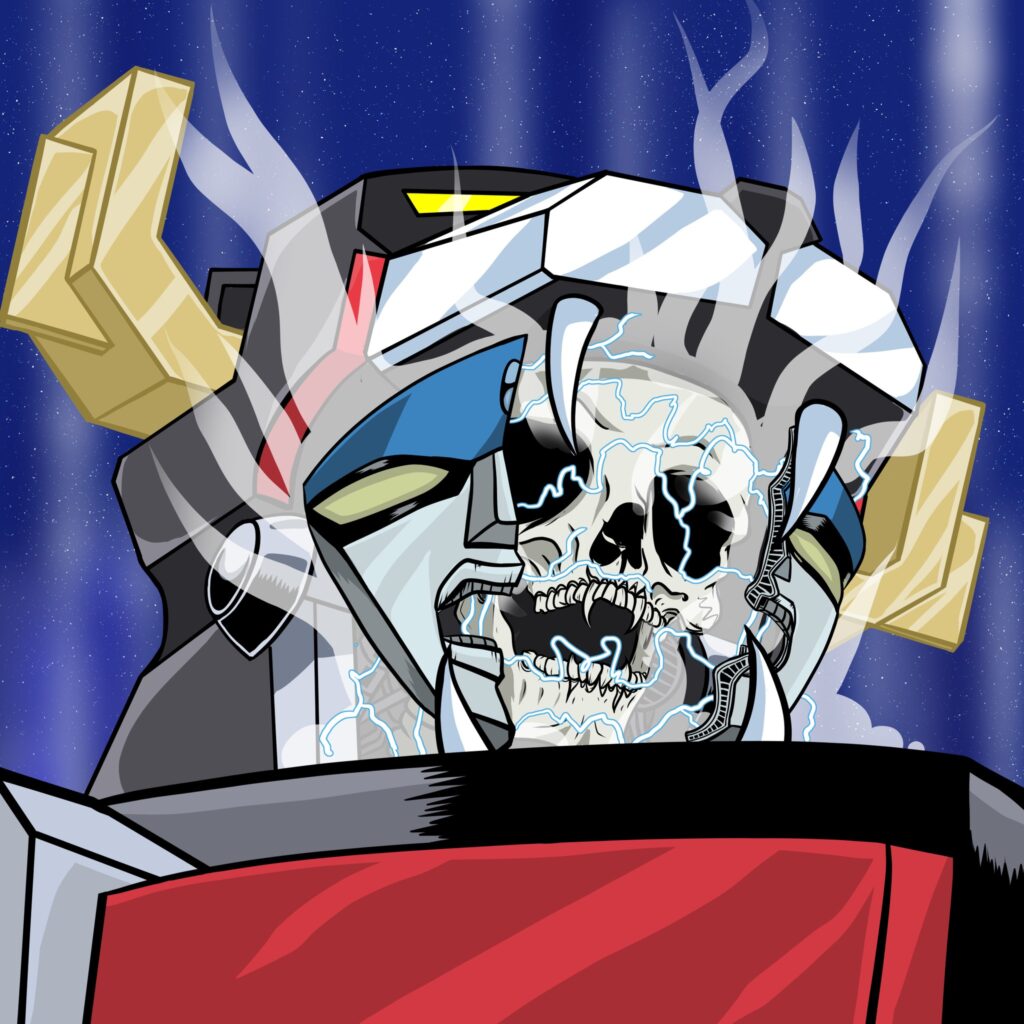
MM: Yeah, definitely. It does sound more like a brand name than a person’s name. Have you ever had anyone from your day job find out about your art and have a reaction, either positive, negative or indifferent?
QUIBX: No, there are people at my day job who do know my art and they think, oh, that’s cool. It doesn’t really go any farther than that. But I think I used to do some slightly more controversial stuff. I don’t know if that would get me in trouble, but it might require a little explaining, a little context. But no, I haven’t been doing a show and then somebody I work with shows up like, oh, that’s you? I haven’t had that happen yet, but I wouldn’t be worried about it. I’ve had people that I know in real life that I don’t work with that have shown up and either didn’t know that but… I mean, if you know me in real life, you know that I draw. So it wouldn’t be a surprise to see me behind a table with art, but it’s more like, oh, you’re doing this? So it’s fine. One of the great things about this Sefl Made thing is my partner in that is very outgoing. Before we met, she had always said, I was already a fan of your art before I fell in love with you. And she will hype me up to people that come into the booth, and she’s very good at that. And that was something that I always struggled with.
MM: It’s great that you compliment each other like that.
QUIBX: That’s another reason why this partnership works out because our skill sets with people complement each other. And it makes that interaction when people come into the booth so much easier.
MM: Nice, nice. And in what area do you think that you do better than her?
QUIBX: You mean in sales?
MM: No, but you said she’s better at talking to people so I am just wondering if there’s some area you’re better at?
QUIBX: I’m logistics. I am good at finding shows to do. And if she has an idea, I go, “this is how we can execute that idea, and this is the material that we need, and this is how much it’s going to cost,” and that kind of stuff. When we met, she largely was selling jewelry that she made. And I learned after we met that she was also an artist. Jewelry was a way for her to make some money but she always wanted to do art. But she never had the confidence or the resources. She didn’t know how to make prints. She didn’t know how to bring the art into the computer and sort of standardize it so they were all the same format and size and all that. And that’s where I came in. I said, “all right, you’ve got this big body of work, and it’s really, really good. Let’s put that out alongside your other stuff and see how it does.” And she sells as much, if not more, art than jewelry now, and we’ve been talking about how she has an interest in phasing the jewelry part out and focusing more on the art because the jewelry part of it is physically tough on the body. There’s a lot of hammering and stamping and things like that, and she has some health issues that make that difficult, that repetitive motion. So the fact that we met and we were able to sort of foster this part of her creative life and make it a thing is what I bring to the table. And she’s the one whose personality brings people in. And people love us together. We’re kind of obnoxiously sappy, right? And kind of disgusting in a way, but in a good way. And people like that because you walk around artist alleys and people are just kind of behind their booths by themselves, kind of flat-faced, and we’re different.
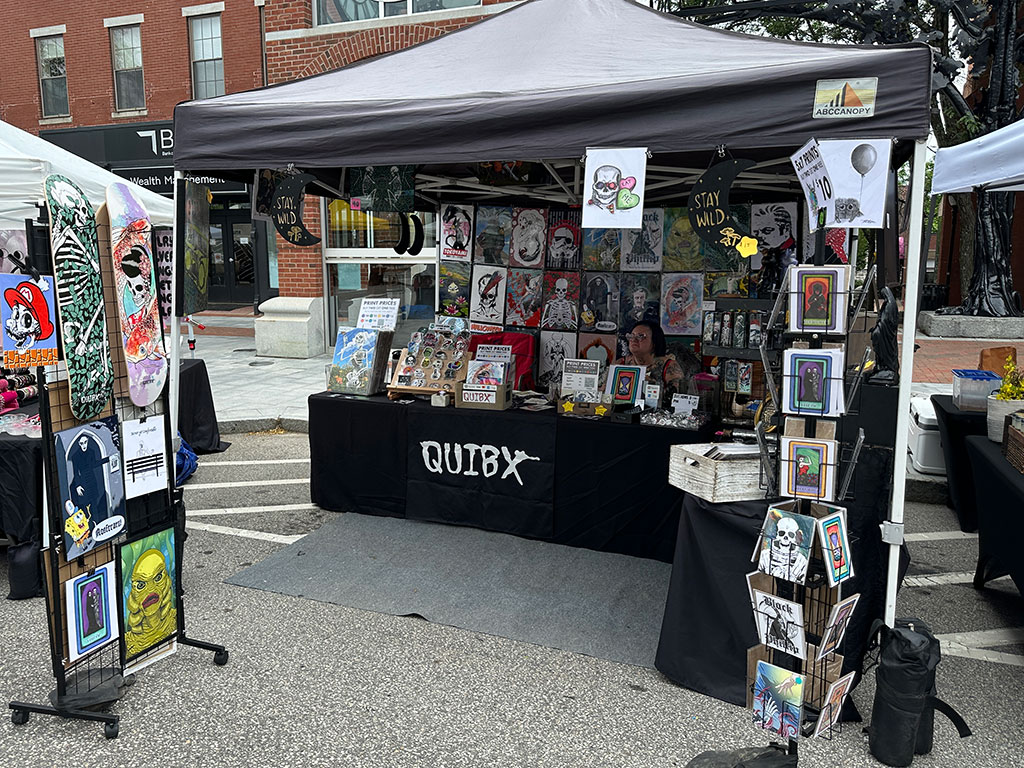
MM: You have more personality
QUIBX: Yeah, and we never get tired of each other’s presence. We’re joking and it’s fun, you know? It’s like, I mean, I always liked going to Vinyl Destination because I liked talking to Dave, the guy that owns it. The records were great, but you liked being there because the people there were nice and knowledgeable and not judgy and this and that. And I think we’re like that, you know?
MM: Sure. Absolutely. So, who are your primary influences today? I know you were really into Pushead when we were younger.
QUIBX: Yeah, yeah.
MM: Whose kind of careers have you followed or been most impressed or influenced by?
QUBX: It’s interesting because there have been many different things over the years where you find an influence and you kind of follow their work a bit, and then you sort of begin to see behind the curtain a little bit, and then you go, oh, that’s not magic in a way that you thought it was. It’s just a guy, but they’re just fucking talented. My earliest influence was comics, right? So a lot of my line work still harkens back to comic book work, that those stark black and white, bold lines. John Byrne, Rick Leonardi, P. Craig Russell, early comic book guys, they had such great line work and I always loved their styles and their composition and things like that. And then manga hit, and I really liked manga stuff. But at the same time, skating — skateboard culture — happened, and I loved the board graphics back then. My God, so amazing. And I was like, “I’m going to do this”. And that’s where I learned about Pushead. It was actually more from skating than Metallica. I was early into skate culture in the 80s, and Thrasher magazine. The whole, like, DIY vibe of that black and white newsprint magazine, and they had all this cool art in there, and all the skateboard decks had the art. I fell in love with that. And then I would see that art cross over into other mediums when I saw people like Pushead doing things for Metallica. And there was this [realization that] the art doesn’t have to be limited to just this genre. It can cross platforms. And I, of course, aped his style very early on. I still hear it to this day, like, oh, it reminds me of Pushead. And I’m like, yeah, I guess, but it’s different now.
MM: And you’ve really evolved as an artist over the years.
QUIBX: I went on and started learning about poster artists for rock concerts. The late 90s, early 2000s was like a heyday for poster artists. People like Kozik and Coop and Brian Ewing do these really bold screen-printed concert posters. One of the things about Pushead’s work that I moved away from is the hyper-detail. And I became more sort of zen about the line work in itself. I do like the hyper-detail a lot, but it’s not where my art landed. So I’ve actually, if anything, simplified and streamlined my style since then. But now, I’ve actually almost distanced myself from following a lot of artists. Except from the people that I meet at shows. And that’s more of getting inspired by people’s motivation and their hustle and their dreams and their desires. It reminds me that you can do this, right? They’re out there hustling every weekend and making it happen. Why are you not? So I think also removing myself from following other people artistically has helped me develop my own style more on its own. I find more influences in music and media than I do in, visually, other people. I know that if I look at too many artists, I’m going to find an idea that I’m going to want to use, and it’s tough to not do so, right?
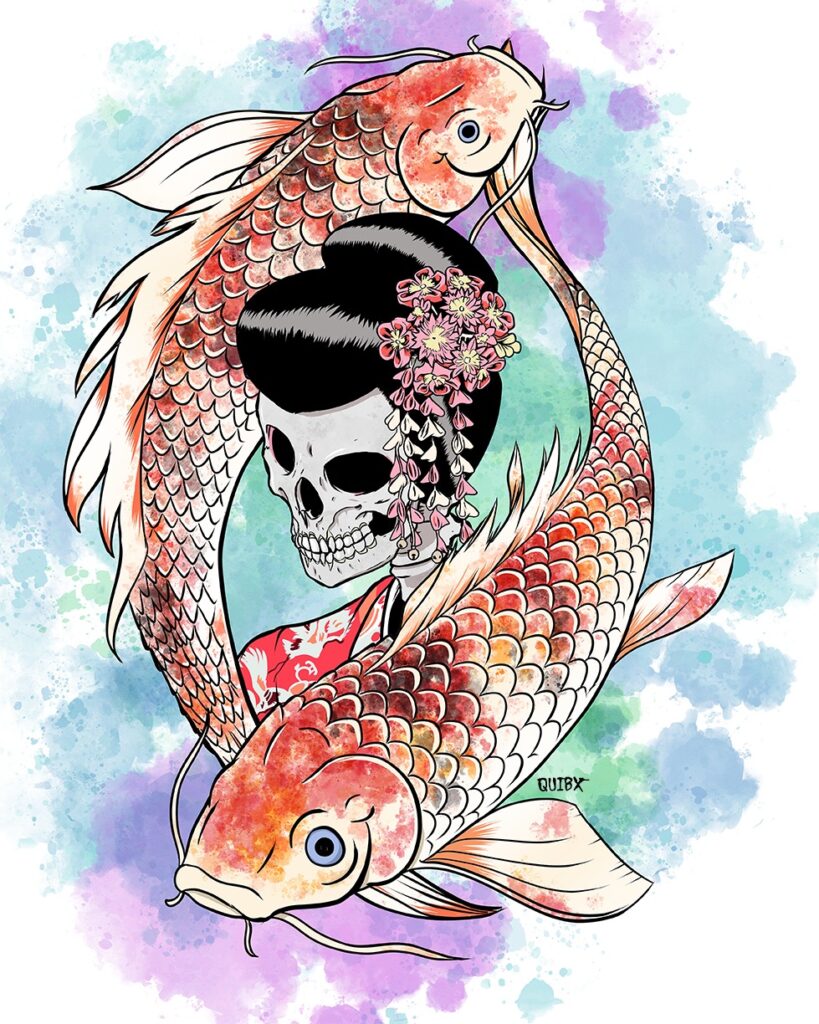
MM: What are your goals as an artist at this point? Would you like to be in art magazines or art galleries? Where would you like to take things?
QUIBX: That’s a question I ask myself a lot, and I’m not entirely sure. I guess the short answer is that I want my art to transcend me. That after I am gone from this world my art will live on in some way, whether it’s still hanging in someone’s bedroom or in a museum or whatever. But I don’t get to decide that, right? Short term, I’d like to get more involved with music, doing artwork for bands, album covers, shirts, things like that. But I also know the reality of that business is that it’s very hard to break into because there are so many talented people and there’s a lot of A.I. artists. And I get why a small band that doesn’t have any money would go, “why would I pay $500 for this illustration when I can have A.I. spit it out?” And so I don’t love that idea, but I understand it. And you also seem to have to get to a certain level to be able to work with these bands, but you have to work with bands to get to that level.
MM: A classic catch 22. Like I can’t get publishers to read my work because I don’t have an agent but I can’t get an agent because I’m unpublished.
QUIBX: Right. So what I’ve been doing lately is that my partner and I have been doing a lot of local metal shows with a lot of local bands. We’ve been trying to get into doing some work for them to get some sort of music-related things under the belt and then use that as sort of a stepping stone. Because I don’t want to do art markets in a field for the rest of my life. I’d love to be able to get my work being commissioned by a band and I’m just doing commission, commission, commission. That would be great. What we’re doing now is a means to an end to [get to] bigger things. But also, I just enjoy doing it, so if it never went anywhere, I’m happy just creating and putting it out in the world and the fact that fucking anybody wants to buy it at all. Anytime someone buys something and they’re like, I love this, that’s the reward for me. That someone just thought that this spoke to them and they wanted to take it home.
MM: Yeah, when I would get positive book reviews, a lot of that would make it worth it.
QUIBX: And I’ve been doing this now long enough that I’ve had people come up to me and be like, I have your piece in my barbershop. Or I have your piece in my tattoo gallery. Or one guy, I have your piece in my classroom. That was just like, wow, there are kids coming to class every day. See, I did an Edgar Allen Poe picture and it’s in this guy’s classroom and it’s been in there for years. Kids come in every year and see this. And if one kid goes, I remember that picture, that was cool and I want to make some art. I can’t even… That’s amazing. I would die happy with that.
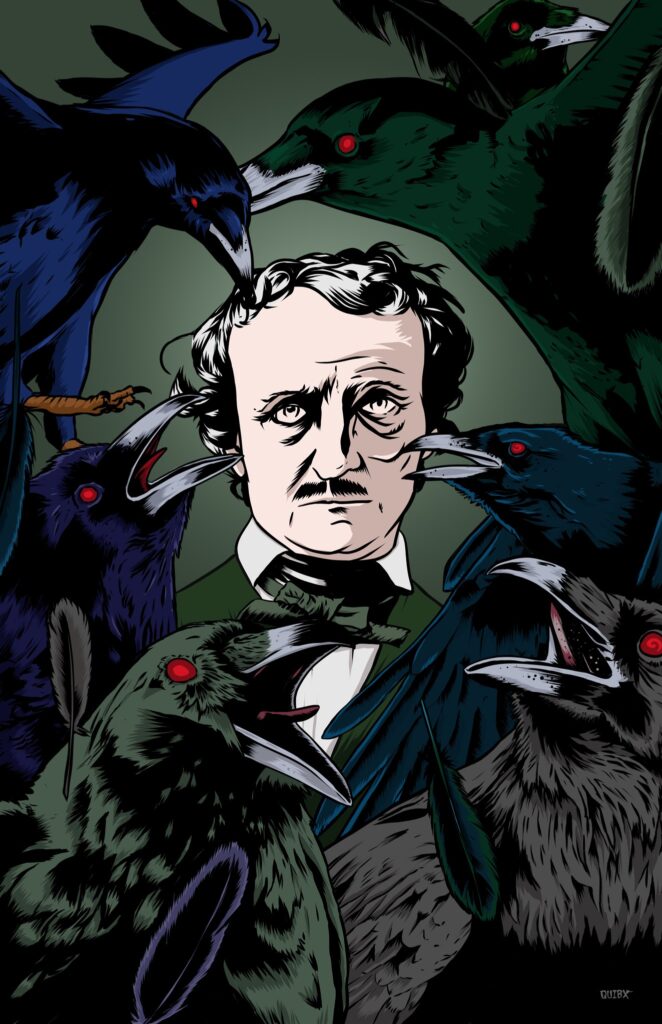
MM: I imagine you could do pretty well selling tattoo flash art if you were ever to put energy behind doing that. Is that something you’d like to get into at all?
QUIBX: Nope. I’ve done tattoo designs for people on commission. And I’ve learned about the whole world of tattooing recently because my partner is very tattooed as well. And I’ve met a lot of artists. And tattoo people generally do their own flash. Unless you’re a shop, then sometimes they’ll buy flash. But the flash is from other tattoo artists. And I am not a tattoo artist. So for someone who doesn’t do tattoos to try to get their art into a tattoo shop, the tattooer is like, why would I buy flash from this guy when I have plenty of flash here?
MM: True.
QUIBX: My Dad used to always be like, you should do tattoos, you should sell your art for tattoos. It’s from people who don’t understand the industry and how it works. Yes, my artwork does look very tattoo-like. But all these people who are doing tattoos, they are all artists. And they have their own flash. And that is what they’re selling. Unless you’re like a famous tattoo guy with a name like an Ed Hardy or a Sailor Jerry or whatever.. People will get that flash because it’s iconic and not just from some guy. I have done plenty of art for tattoos, but it’s been on request.
MM: Have you ever had a show at a gallery that you are the main attraction yet?
QUIBX: Interestingly enough, no. But I have one in September. And it’s weird because sometimes you go into cafes and coffee shops and there will be an artist that has their work on the walls. And I’m doing that at a Mexican restaurant in September. Dos Amigos up in Concord, NH. I’m taking over the art in that restaurant for the month of September. We’ll have an opening, but I don’t know what date it is. Probably the first weekend of September. I’ll have like 20-something pieces up on the wall.
MM: That’s great.
QUIBX: It’s kind of interesting. And that was a thing that came from another show that I had done. Sometimes you do these shows and you may not sell a lot, but you make these connections that lead to things. And this was one of those things. So that’s pretty cool. I’m actually gathering pieces now to frame to hang up in a restaurant.
MM: Cool, cool. I know at one point you had put some of your art on Society6 or Designs by Humans, one of those companies that does t-shirts and stuff. How did that go and why aren’t you more into that, I’ve wondered?
QUIBX: Well, there’s a lot of reasons why I don’t do that so much anymore. One is I don’t have any control over the product when it comes out. So I upload my art, they put it on a shirt, they send it to a customer. I don’t know if that shirt’s good or not good. And it’s my art. I want it to be represented well. Secondly, those sites are rampant with copyright fraud and outright theft. And designs get stolen because they appear on those sites. I’ve had to do takedowns on Threadless, on Redbubble. Someone just finds something and puts on a shirt and steals it. And these companies give zero shits about any of it until someone complains. There are no safeguards in there to keep anyone from doing it. So I would rather not do business with those companies. Especially now that stuff’s showing up on Temu and Shein. There’s so many; they just don’t care about the art. Those companies are neat for like, oh, I want a novelty shirt with a Star Trek saying. It could be an original design, but zero fucks are given about copyright in there. So I’d rather not do business with them. I did for a brief time, I had a print-on-demand company that integrated into my Etsy shop. And I ordered one. And it was okay, and I was good with it for a period of time. But those things also take so much of a cut of your design. So you could sell a t-shirt for $25, but you make $1.50. Whereas if I screen print shirts, I can make $10 a shirt. And I’m in control of it.
MM: If someone asks you to sign something when they’re buying it, how do you sign it?
QUIBX: I sign it Quibx. I bring a couple of metallic Sharpies. Some people have said that you should ask every customer if they want you to sign it. And I feel that’s presumptuous. If people ask me to sign it, I will. But my signature’s already on the print. My prints aren’t limited edition, as a rule. So if they want it, I will happily do it. But I don’t sign everything by default. Some people just want the design. That’s fine. I don’t have to dictate how the consumer wants it.
MM: How much of your art is done by hand? And how much is done by computers and other methods? Because I know you sometimes start things with one medium and finish it in another.
QUIBX: It all depends on the nature of the piece. I still sketch out a lot of my initial work in pencil. But I rarely get past the pencil phase before I bring that into digital. Because what digital allows me to do is it allows me to iterate very easily. So as opposed to pencil, erase, pencil, erase. Now I can get my basic idea down, get my proportions, my composition, whatever. And then bring it in if I need to skew it by a couple of degrees. Or duplicate a thing or whatever. It’s so much easier to do that. So I feel like it has an organic feel to it that’s been complemented digitally. Earlier pieces, I would go all the way to the inking level [by hand]. And then scan the inks in. And then just color them digitally. Or if it’s an original, just watercolor or paint or something. Then I went full digital for a period of time. And now I’m easing back on that. But I have acrylics on canvas. I did a watercolor piece a year ago. That was full traditional pen, ink, and watercolor. But then here’s where it gets interesting. When I was doing that watercolor, I stopped at the line art. Scanned it. And then finished the watercolor. To have a finished original piece. But then I took that line art and brought it in and digitally colored it. So my prints are of the digital piece that starts from the same line art. But I still have an original piece that’s for sale out there. That is 100% physical.
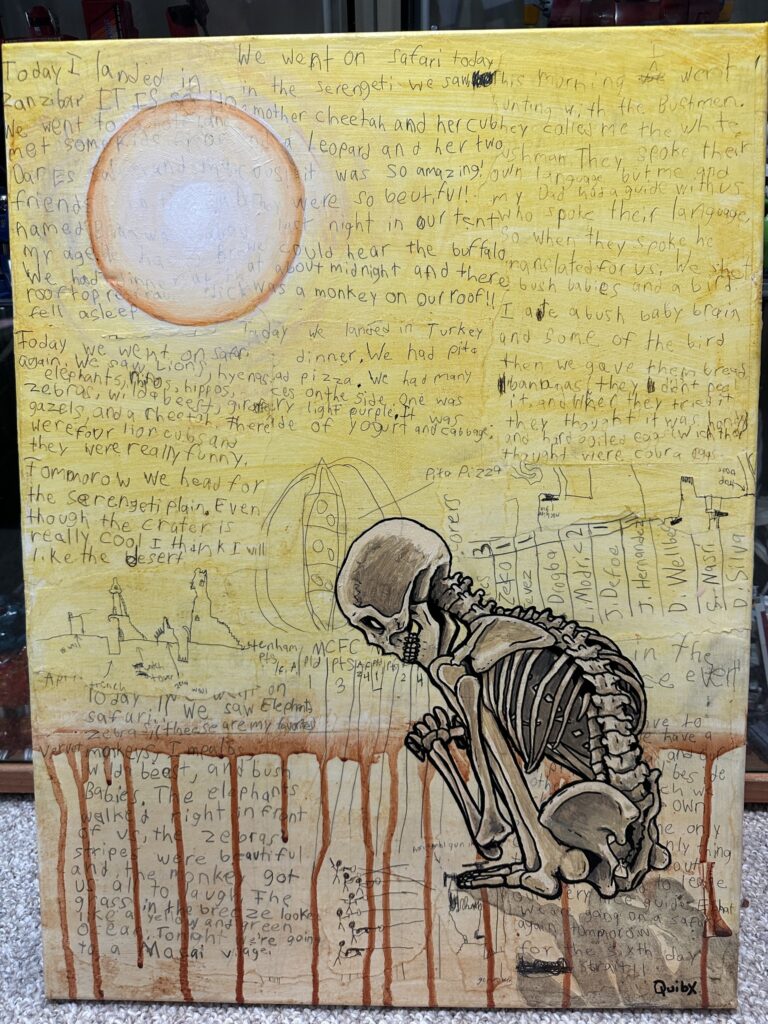
MM: Interesting. Is that the only instance where you’ve had something where there are two versions like that?
QUIBX: There’s been a couple. I have a few pieces that I’ve painted that only exist as paintings. And I don’t want them to be prints. I want to save the experience of that painting. And it is a singular thing. But the Poe piece started out as a painting. And people loved it. And I made a print out of it. And sold the prints. But the original painting sold. And that’s the only original that there’s going to be. And that guy has a one of a kind painting.
MM: Do you give names to your artwork? Does each piece have a title?
QUIBX: Yes. But more out of necessity than out of want. When I’m selling the prints, sometimes I’m working with people. And I need to be like, “I need this print.” So sometimes it’s very much like unimaginative titles. But just so I know where in the bin it is. I know some pieces, like you go to a museum. You’ll see this piece. And you’re like, I don’t know what that’s about. And then you see a title. And you’re like, “oh, that contextualizes it.” I tend to not do that. I like the pieces to speak for themselves. So I tend not to give titles that will lend any different meaning than what you see visually in the art. I let people figure it out.
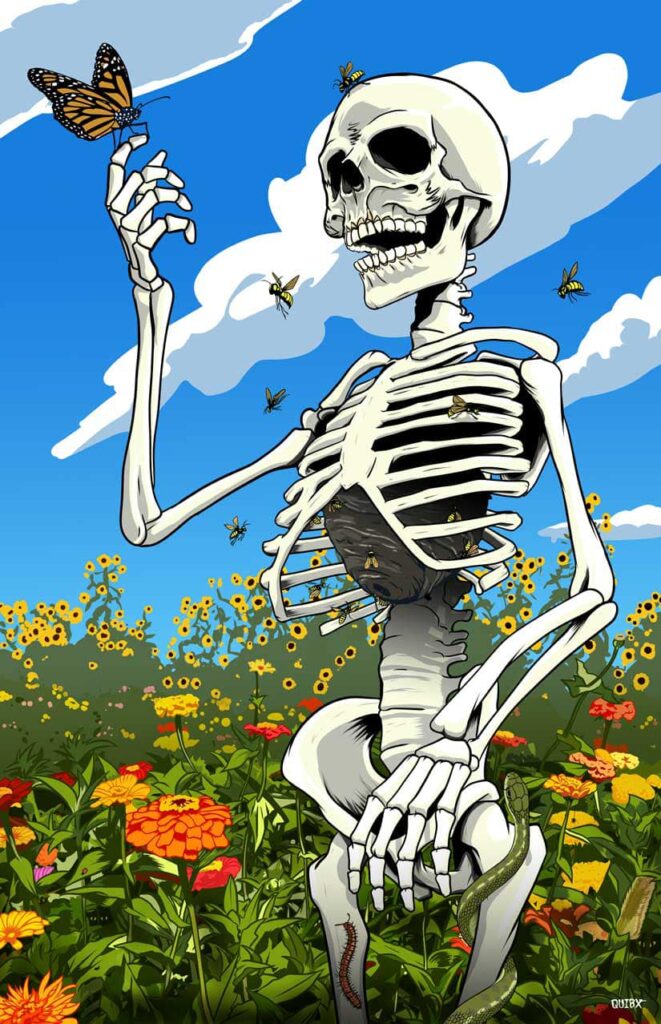
MM: Do you tend to draw more or less when you’re experiencing extreme emotions?
QUIBX: That’s a good question. When I was younger, more. It was definitely a way to deal with the world. And deal with angst of being a teenager. And turmoil and all of these things. But now, I find that when I’m going through a lot of shit I actually don’t draw a lot. But when that moment is past, those experiences inspire the art. You know what I mean? It’s like a way to process the trauma after it happened. But in the middle of it, if I’m in the middle of the shit, I don’t sit down and turn to drawing as therapy.
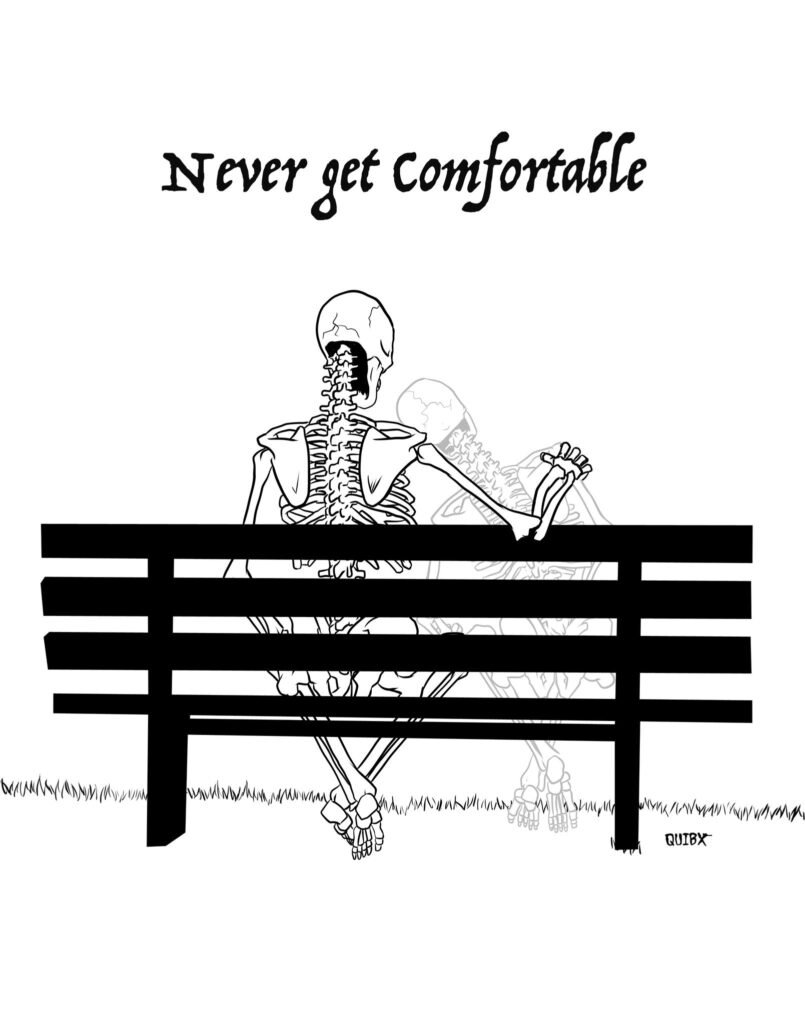
MM: Do you ever make art anymore that is exclusively for you? Like, I’ve got this idea. I’m going to draw this. And this is not something I’m going to sell. It’s just going to be for me. Or maybe you’re drawing it for someone in particular. And it’s a gift. Not for the crowds.
QUIBX: Yeah, I’ve done that. I’ve done gifts out the door. And I’ve done pieces for myself. But usually, if it’s a piece that the world doesn’t see, it’s either too personal or I don’t think it’s good enough. And one of the things about working with a partner is that they look at your art in a different way than you look at your art. So I’ll see a piece and I’m like, “I don’t think this works. I don’t like it. “ And they’ll be like, “no, no, you need to sell this.” And it lets you get out of your head a little bit. It’s such a weird process now with the ideas that I have. I have a little notepad that I’ll write down a phrase to remember what I was thinking of. And then when I sit down to do it, usually it’s with the result of having a finished piece to show the world. But there are times when there’s just a piece that is just for me. But they never reach the sort of fidelity that a piece that’s being put into production does.
MM: How good would you say you are at predicting which art is going to sell? How often are you surprised when there’s something you don’t think is one of your best, but it ends up being a huge sell?
QUIBX: That’s so weird because I’ve had pieces that I’ve been so excited about that nobody’s fucking interested in. And I have pieces that I just kind of put together that people love. So it’s hit or miss. There is a formula I’ve noticed over the years with my audience. And my audience is honestly overwhelmingly young women. You know, like late 20s, early 30s, women with some tattoos love my art. And I don’t know what about it specifically they like, but there’s a certain… The pieces that I sell the most of have a “feel” that I know I can replicate, but I don’t want to pigeonhole it, right? I’m doing some things now where I’m actually revisiting some older pieces that I did earlier in my process that I look at now and go, they don’t feel like they fit as well, and I want to capture the spirit, but bring up to date. Some of that’s through like customer requests, some of it’s just through me. Like one of my best-selling pieces, you would think it’d be crazy to muck with it, but I am. Because I’m not happy with it, but this one print outsells my other ones like three to one, it’s crazy. It just resonates with people. And I’ve tried a few others that I kind of channel the inspiration to do something different, and they sell really well too. I don’t want to say the sales are dictating what I do, but they’re helping me realize what I’m good at.
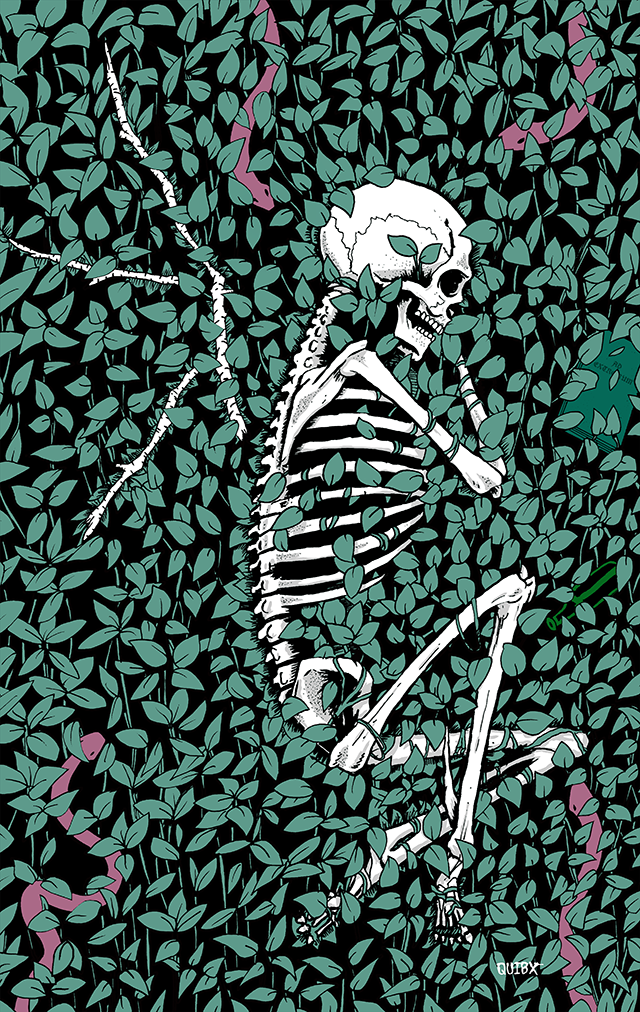
MM: Makes sense. You figure out what it is about what you do that people latch onto.
QUIBX: People like when you do this or that but sometimes they don’t resonate. Like when I switched to color. When I first started out, everything was black and white. And I was so afraid of color, and I did like one or two color pieces, and those just took off. And I went, oh, maybe I am okay at color, and people like this. And now most of my work is color, and there’s very few black and white pieces.
MM: It reminds me of Metallica. They said we don’t do music videos, but they made a music video for “One.” And it was so overwhelmingly huge that every single after that got a video.
QUIBX: It’s strange how what you think people want [can differ from] what they want. I had what I thought were really cool ideas that I went in on. Like sketchbooks or something. I made a run of 20 sketchbooks three years ago. I still have 10. I thought it was so cool. I made the cover and everything else. It was great. All my art, low price. Almost no interest. So you just take those things out of rotation.
MM: It’s good that you’re able to constantly come up with new stuff so you can do all this trial and error and figure out what’s going to be successful.
QUIBX: Especially where I’m geographically limited right now to New England. I’m at a lot of shows and I want there to be something new when they come back. I don’t want it to just be the same art every year. Every year, I try to have three or four new pieces and try to pull out. Basically, my art will be the greatest hits, right? You just learn what works and what doesn’t work, and it just evolves over time.
MM: Now, you’re out almost every weekend a lot of times.
QUIBX: It feels like it, yeah. Festivals, fairs.
MM: Tell us about some of the more interesting ones you’ve done and the more successful.
QUIBX: I’ve done events that nobody has showed up to, literally. We showed up, and then the dude forgot to promote it or something. We once drove to a field in Vermont at this hippie farm that was supposed to be this hippie fest kind of thing. I don’t know if everybody canceled, and I didn’t get the memo, but literally, it was a weird thing where these unhoused people were camping on the dude’s land, and those were my only customers. I just gave art away because it was just so wild. But then I’ve done shows that have had 60,000, 70,000 people. I’ve done Salem Mass at Halloween, and then Salem gets a million people that come through there. The crowds are insane, and it is a massive undertaking. But it is incredible when the right audience is there, how much art you can move. I get analytical. I write down every sale. I figure out how much of what print sold, and then I make adjustments based on what sells well and what doesn’t sell well. Because when you do these big shows, space is at a premium. You have only what you can fit in your vehicle. If you’re outdoors, you have a 10×10 tent, and you’ve got to maximize your space. So the difference between hauling an extra set of prints around could be whether all your shit fits in the car or not.
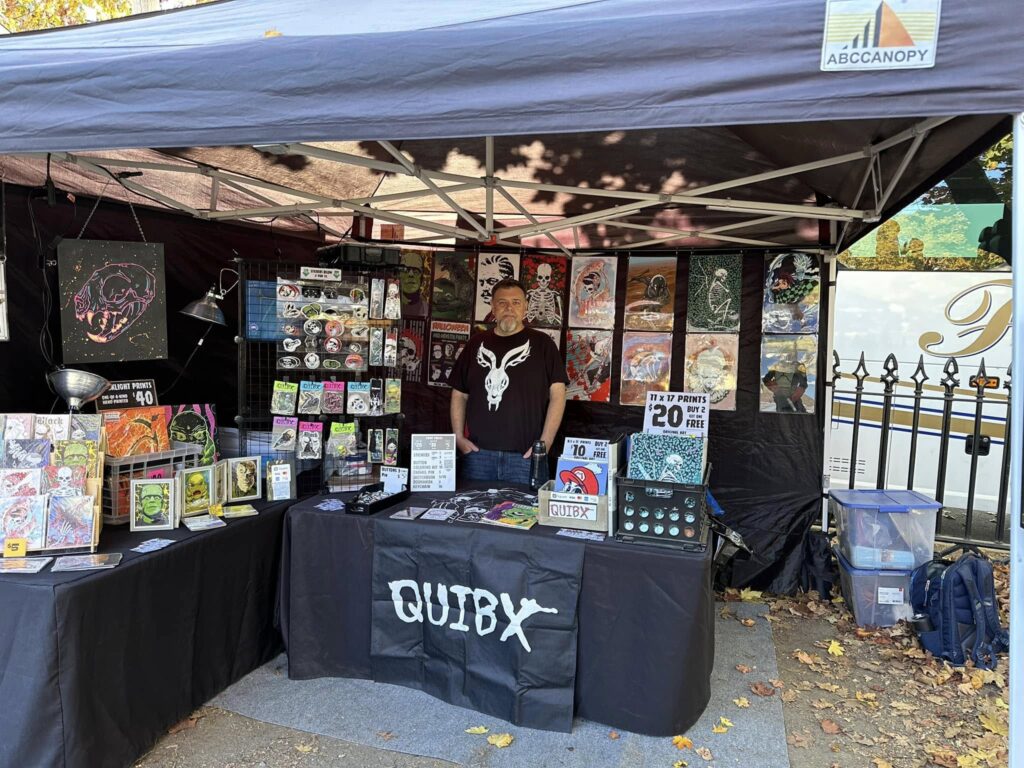
MM: Yeah, you seem to be really good at maximizing your space because I’ve seen your photos from different things. You’ve got so many products, but it doesn’t look too cluttered. Everything just kind of fits perfectly.
QUIBX: I’ve learned over the years on how to merchandise and how to put items at customer eye levels and how to attract their attention with fascinators, things that will drag them in from just walking by to being in your booth. We have a spinner rack now that we put all our small prints in that people can spin. It looks like a greeting card rack. That’s been fantastic because it encourages people to rotate it, and people love to touch things.
MM: Right.
QUIBX: Dumb little nuggets of information that you learn. Say you make an enamel pin. If you have one enamel pin on the table, nobody’s going to buy it. If you have a board with 20 enamel pins, people will buy one. They like the illusion of choice, even though at the end of the day, they’re just buying one. So if you’re going to try to sell a thing, have a variety of that thing that makes them think they’re making a decision and they take some ownership. Just things like that I never would have thought of before I started doing these shows. Every show, you learn something new about your process. When I started doing shows in the fall, it gets dark at like 5, so how does all this look at night? How are you going to deal with the cold? How do you bring stuff to stay warm? Things that you never would think that you had to think about. I love Tetris as a video game, and I was good at it, so I feel like when I’m loading my car, it’s like, “how can I consolidate these bins into the smallest space possible so we can efficiently move things in and out?” I enjoy that part of it too. Logistics is fun for me.
MM: Aside from the creativity, you have a gift for being able to analyze and figure things out.
QUIBX: A lot of that I can trace to my dad. He thinks like that. He’s very mechanically minded. We were poor, so we didn’t have the luxury of if something breaks, you hire a mechanic, something leaks, you hire a plumber. Either you learned how to do it, or it didn’t get done. I think I learned those problem-solving skills of, “here’s a problem, what resources do I have that I can use to fix this? Or who do I know that can help me fix this?” I just learned to pay attention and to learn. I’ve applied that to my job, to my life, to this stuff. I think it’s one of my biggest assets. I don’t think I’m very creative in a way. My partner is so creative. She can come up with ideas, just the ideas that boom, boom, boom, boom, boom. I’m in awe of how easily those ideas come to her. They are often difficult for me, but when I do have that idea, I am able to apply the skills that I’ve learned through my life to make that idea the best version of it it can be.
MM: You know something, I don’t know if you’ve said your partner’s name yet.
QUIBX: Heather. Her Instagram is Salty Jewelry for Assholes. She has this cool punk attitude with jewelry and everything. Her art, she is putting under Salty Monster. All three of those brands, Quibx, Salty Monster and Salty Jewelry for Assholes are all under the Sefl Made banner. When you come to an event that is under Sefl Made, you will see all products from those three. It gives us the freedom to do different things. If we wanted to bring somebody else in under the banner, we can do that. The talent that flows from her, that’s true creativity from an artistic sense. The ideas are rapid fire, almost so much that at times we have to prioritize. “These are all great ideas, but we’re two people. We need to focus on this right now.“ That’s where my skills come in. I can take these ideas and go, “this we can do, this we can’t do, this we can do, but it’s going to take a bit of work.” It’s a longer term thing.
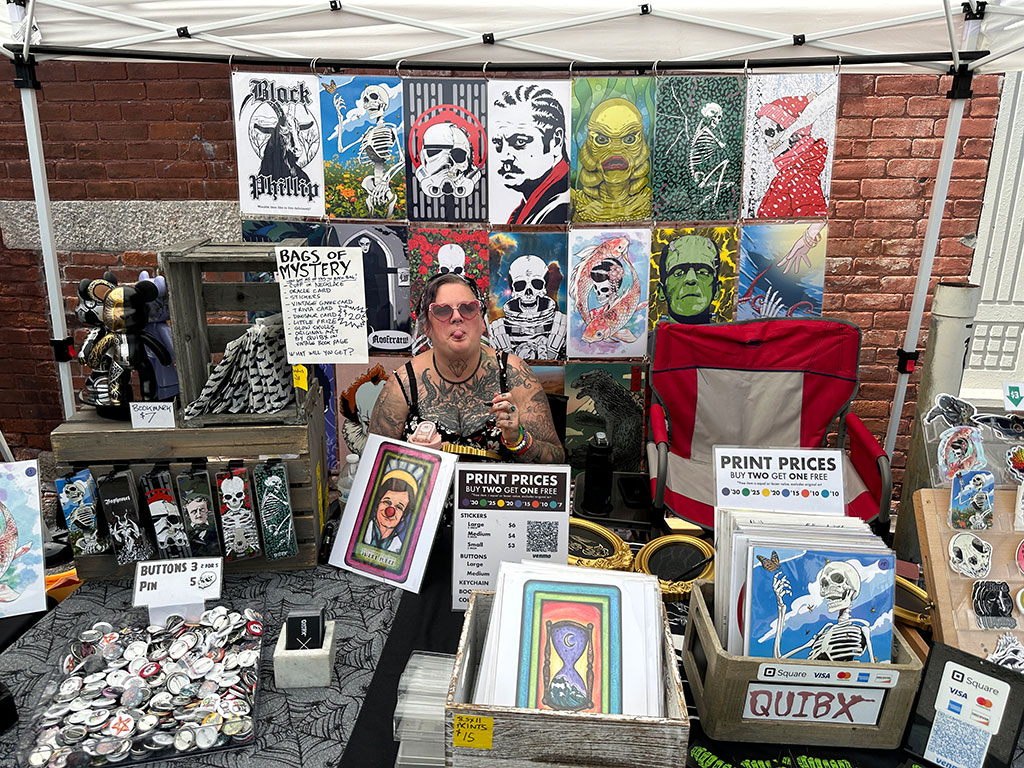
MM: Sure, sure. We used to go to Weirdo Wednesday at the Luna Theater in Lowell. How much is your artwork inspired by your taste in odd movies?
QUIBX: A lot. I don’t know if it’s my brain or ADHD or whatever it is, but I find things that are normal and predictable boring. With a regular movie, like a thriller or something, I’m one of these people that watch it and go, “Oh, that guy. That guy did it. This is exactly what’s going to happen. It happens, and that bores me.” I find it with a lot of boring pop music that it’s executed just fine and I know a lot of people love it, and I’m not shitting on it, but for me, I just get bored with it. These weird movies, even bad movies, they challenge you in ways that make you go, what decisions happened to make this happen? I never would have done that. It just blows my mind when they zig and zag.
MM: Right. They surprise you. You can expect the unexpected.
QUIBX: I’ve always thought that with music, when an artist or a band is just starting out and they don’t have a lot of resources, the music that comes out of that period is usually their best because they have constraints that force them to be creative to solve the problems. I find that with movies, too. When someone spends $500 million on a movie, it’s almost boring because you have too many safe decisions with too many committees as opposed to if you’re making an indie film and you’re in creative control, but you find interesting and creative things to do based on your limits. I love getting a set of parameters or restraints or problem solving to figure out how to do something. Weird, cheesy, foreign movies do that for me, although the stories might suck. There’s always something about them that is endearing. This was somebody’s passion, even if it was misguided. This was something where somebody had a dream, and maybe it didn’t come out right, but you can see specks of brilliance in there. I try to recognize that and harness it if I can. Not always to good results, but the idea is there.
MM: Is there anything else you wanted to talk about? I know we were talking a little about A.I. before, but we don’t have to get into that if you don’t want to.
QUIBX: It’s up to you. We can talk a little bit about it. I can tell a little bit of the story about the Sefl Made thing and what that has affirmed my anti-A.I. stance a bit, in art anyways.
MM: Sure.
QUIBX: With Heather, she was a vendor and I was a vendor. We had both crossed paths over the years at different shows, and we always said “hi” to each other and admired each other’s work. We ran into each other at a metal show, both vending, at a time when we had both gone through a breakup. We just started hanging out and got together, fell in love, and then we just both admire the shit out of each other’s art. We started doing all that together. As we do these shows together, and this is when her mind is sort of brilliant, she still does have a sign on her table that says, “I have four kids, buy my shit.” People look at the sign and they’re like, “oh, that’s funny, you have four kids?” It’s a conversation starter. Her and I talk a lot about A.I. and art and the ethics of it and how a lot of it doesn’t recognize the art that was used to create the database that A.I. uses. A lot of it we think is unethical. She made a sign that we put up in our booth that says, “no A.I. is used in this art. It’s all handmade from two nerds who fell in love and started a business.” The reaction to that has been so positive. When we see people come up to the booth and they see that sign, they want to come in and have a conversation with you about it.
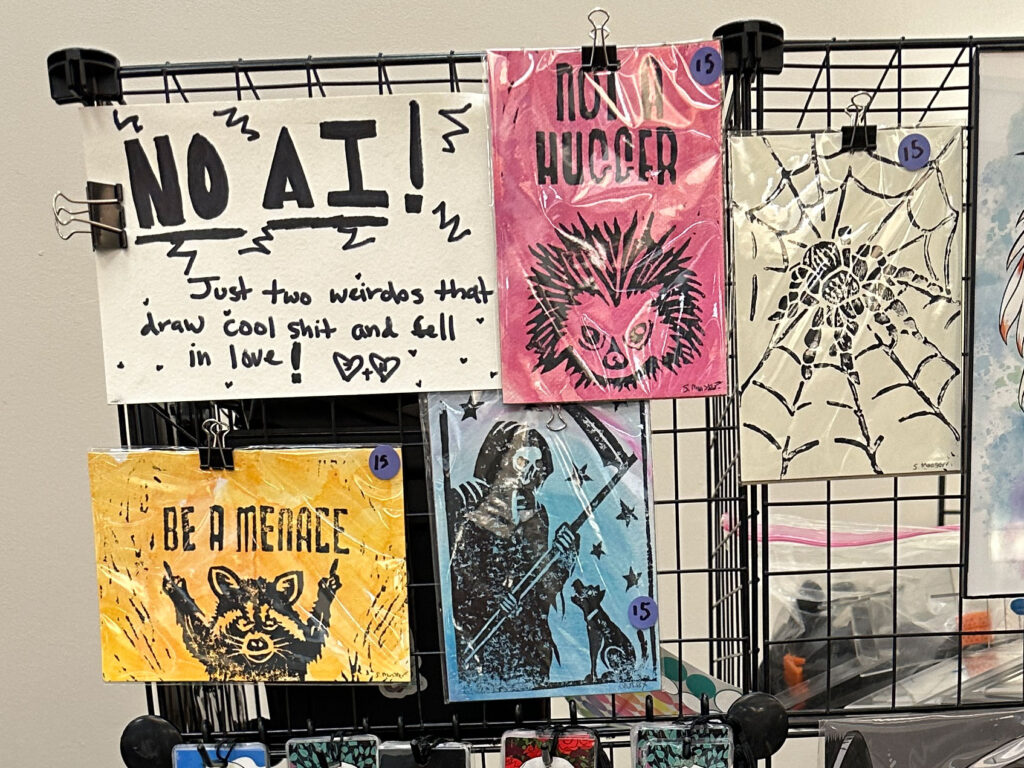
MM: Interesting.
QUIBX: As people who are consumers of art, they feel the same way. It becomes more and more hard to tell when you’re at these events what is made by a person and what isn’t. None of it really explicitly states if it is or isn’t. You do these shows a lot and you see a lot of 3D printed dragon things. The kids love that stuff, but as an artist, I know that nine times out of ten they just downloaded a pattern off the internet and printed it off on their printer. Or even just bought the shit pre-printed wholesale from China. That kind of commodification of art and theft rubs us the wrong way. I’ve used A.I. in non-art related scenarios. There’s a lot of positive things that A.I. does, but in art, I don’t want it and we don’t use it. I think that’s just going to get harder and harder to tell what is A.I. I think we have to make a stand. I actually did an experiment once where I asked Chat GPT to make art in my style. To look me up on the internet, find my art and create original art based on my style. It was really interesting. It didn’t look like my art, which was good, but it knew that it was like skulls and gothic and that kind of thing. But it’s only a matter of time until someone’s going to be able to punch that in and say, make me art in the style of Quibx. It’s just going to be indistinguishable from that artist. So I want to hold on to that handmade-ness as long as I can.
Links:
On the web:
Instagram:
Etsy:

Leave a Reply